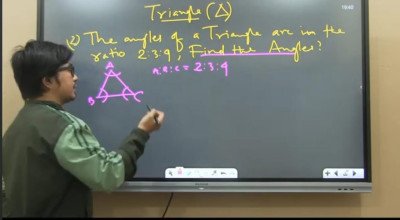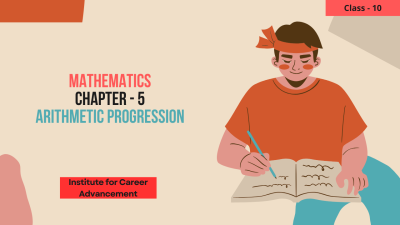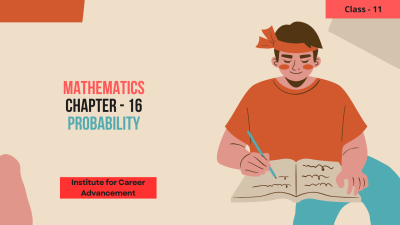Course description
Studying probability in Class 12 typically involves building upon the foundational concepts learned in earlier grades and delving into more advanced topics. Here's an overview of what you might cover in a Class 12 probability curriculum:
Basic Probability Concepts:
Review of fundamental concepts such as sample space, events, and outcomes.
Understanding probability as a measure of the likelihood of an event occurring, ranging from 0 (impossible) to 1 (certain).
Types of Events:
Discrete and continuous random variables.
Independent and dependent events.
Mutually exclusive events and exhaustive events.
Probability Distributions:
Probability distributions for discrete random variables, such as the binomial distribution and the Poisson distribution.
Probability density functions and continuous probability distributions, such as the normal distribution.
Combinatorics:
Permutations and combinations, including the fundamental counting principle.
Applications of permutations and combinations in probability problems.
Conditional Probability:
Understanding conditional probability and its application in real-world scenarios.
Bayes' theorem and its applications.
Probability Theory:
Laws of probability, including addition and multiplication rules.
Joint probability and marginal probability.
Expectation and Variance:
Expected value (mean) and variance of a random variable.
Properties and applications of expectation and variance.
Probability Distributions in Real-Life Applications:
Application of probability distributions in various fields such as finance, biology, engineering, and social sciences.
Real-world examples and case studies to illustrate the practical significance of probability concepts.
Hypothesis Testing (if covered):
Introduction to hypothesis testing and significance levels.
One-sample and two-sample hypothesis tests.
Understanding p-values and making decisions based on hypothesis tests.
Statistical Software Tools (if applicable):
Introduction to statistical software tools like R, Python, or Excel for probability calculations and simulations.
ক্লাস 12-এ সম্ভাব্যতা অধ্যয়ন করার ক্ষেত্রে সাধারণত পূর্ববর্তী গ্রেডগুলিতে শেখা মৌলিক ধারণাগুলি তৈরি করা এবং আরও উন্নত বিষয়গুলিতে অধ্যয়ন করা জড়িত। ক্লাস 12 সম্ভাব্যতা পাঠ্যক্রমে আপনি কী কভার করতে পারেন তার একটি ওভারভিউ এখানে রয়েছে:
প্রাথমিক সম্ভাব্যতা ধারণা:
নমুনা স্থান, ঘটনা এবং ফলাফলের মতো মৌলিক ধারণাগুলির পর্যালোচনা।
0 (অসম্ভব) থেকে 1 (নির্দিষ্ট) পর্যন্ত একটি ঘটনা ঘটার সম্ভাবনার পরিমাপ হিসাবে সম্ভাব্যতা বোঝা।
ইভেন্টের ধরন:
বিচ্ছিন্ন এবং অবিচ্ছিন্ন র্যান্ডম ভেরিয়েবল।
স্বাধীন এবং নির্ভরশীল ঘটনা।
পারস্পরিক একচেটিয়া ঘটনা এবং সম্পূর্ণ ঘটনা।
সম্ভাব্যতা বিতরণ:
বিচ্ছিন্ন র্যান্ডম ভেরিয়েবলের জন্য সম্ভাব্যতা বন্টন, যেমন দ্বিপদ বন্টন এবং পয়সন বন্টন।
সম্ভাব্যতা ঘনত্ব ফাংশন এবং ক্রমাগত সম্ভাব্যতা বন্টন, যেমন স্বাভাবিক বন্টন।
সমন্বয়বিদ্যা:
মৌলিক গণনা নীতি সহ পারমুটেশন এবং কম্বিনেশন।
সম্ভাব্যতা সমস্যায় স্থানান্তর এবং সংমিশ্রণের প্রয়োগ।
শর্তাধীন সম্ভাবনা:
শর্তযুক্ত সম্ভাব্যতা এবং বাস্তব-বিশ্বের পরিস্থিতিতে এর প্রয়োগ বোঝা।
বেইসের উপপাদ্য এবং এর প্রয়োগ।
সম্ভাব্যতা তত্ত্ব:
যোগ এবং গুণের নিয়ম সহ সম্ভাব্যতার আইন।
যৌথ সম্ভাব্যতা এবং প্রান্তিক সম্ভাবনা।
প্রত্যাশা এবং পার্থক্য:
একটি র্যান্ডম ভেরিয়েবলের প্রত্যাশিত মান (গড়) এবং প্রকরণ।
প্রত্যাশা এবং বৈচিত্র্যের বৈশিষ্ট্য এবং প্রয়োগ।
রিয়েল-লাইফ অ্যাপ্লিকেশানগুলিতে সম্ভাব্যতা বিতরণ:
অর্থ, জীববিদ্যা, প্রকৌশল, এবং সামাজিক বিজ্ঞানের মতো বিভিন্ন ক্ষেত্রে সম্ভাব্যতা বিতরণের প্রয়োগ।
সম্ভাব্যতা ধারণার ব্যবহারিক তাৎপর্য ব্যাখ্যা করার জন্য বাস্তব-বিশ্বের উদাহরণ এবং কেস স্টাডি।
হাইপোথিসিস টেস্টিং (যদি আচ্ছাদিত হয়):
অনুমান পরীক্ষা এবং তাত্পর্য স্তরের ভূমিকা.
এক-নমুনা এবং দুই-নমুনা হাইপোথিসিস পরীক্ষা।
পি-মান বোঝা এবং হাইপোথিসিস পরীক্ষার উপর ভিত্তি করে সিদ্ধান্ত নেওয়া।
পরিসংখ্যানগত সফটওয়্যার টুল (যদি প্রযোজ্য হয়):
সম্ভাব্যতা গণনা এবং সিমুলেশনের জন্য R, Python, বা Excel এর মত পরিসংখ্যানগত সফ্টওয়্যার সরঞ্জামগুলির পরিচিতি।



















